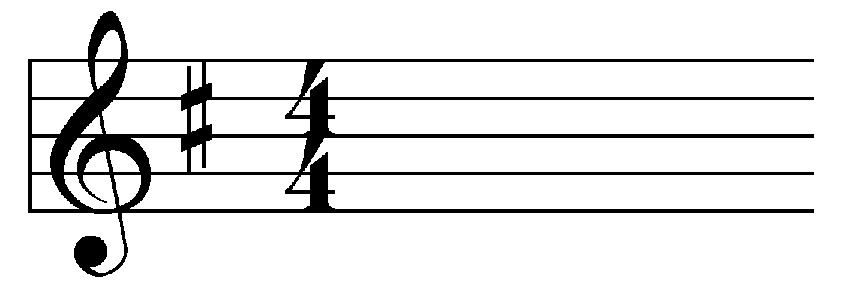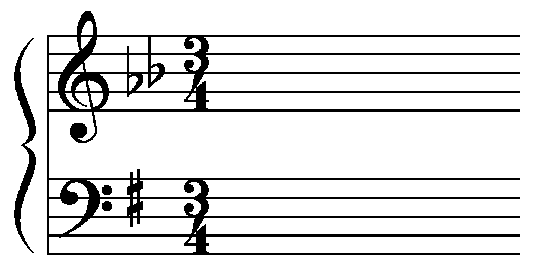5. ACCIDENTALS AND KEY SIGNATURES
(Table 5)
5.1. Accidentals are placed immediately before the note or interval to which they belong, and must not be separated from it by anything but octave signs.
5.2. (11-97) In general, accidentals should always be marked where they occur in print (but see Par. 8.7.3 and 10.6-10.6.1). Where it is necessary to add accidentals in the braille text, they are subject to the same considerations given for added rests in Par. 5.1. Each transcriber-added accidental should be preceded by dot 5.
5.3. Accidentals should be restated at such points as the beginning of a parallel or section, a new page, or after any major interruption, such as a long parenthetical insertion, volta, etc. In vocal and single-line instrumental music it is desirable to re-mark an accidental when a measure is continued on a new line.
5.3.1. As in print, accidentals remain in force during a complete measure, but only for the same note at the same pitch. (See also Par. 9.2.)
Example 5.3-1.
#D%#D4
*"O:'E *:*\W\*O:'E *:*.:W*\<K

5.3.2. (11-97) There is no standard print notation for 1/4 or 3/4 sharps or flats. Among other possibilities are a backward flat sign, a sharp sign with one or three vertical lines instead of two, and arrows going up or down. When publishers notes make the meaning clear, the notes should be included in the transcription and the signs from Table 5 are placed in the braille music line. (See Example 26.27-1.)
5.4. Key signatures are written between blank spaces (unless followed immediately by meter signatures) at the point at which they appear in the print, except that the signature at the beginning of each staff is omitted after its first appearance in a piece. Changes of key are, of course, placed wherever they occur.
Example 5.4-1.
#E%#D4
"R\'I T'V #E*#D< "S['J N'V<K

5.5. When there is an unusual key signature, it should be written as follows: Music parenthesis, hand or clef sign, accidental, octave sign, note(s), closing music parenthesis.
Example 5.5-1. (A) (unusual key signature)
,'>/L'%.Y,'#D4

Example 5.5-2. (B) (piano music)
,'.>'<"!<) _>'%_=,'#C4

5.6. Changes of key should always be marked in each part in keyboard music (or in vocal or orchestral scores) when they occur in a piece or movement, but at the commencement of a composition or movement it is only necessary to mark the signature once, usually in conjunction with the meter indication.
5.7. The first note following a key signature must always have its proper octave mark.
5.8. Music symbols, such as accidentals, generally should not be combined with regular letters. In a title, such as Prelude in C Sharp Minor, or a phrase like music for B flat Clarinet, the sharp and flat symbols should not be used. However, in some theoretical and analytical situations, hybrid signs may be permitted for convenience and expediency.



